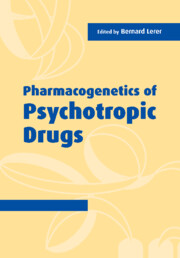Book contents
- Frontmatter
- Contents
- List of contributors
- Part I Introduction
- Part II Clinical background and research design
- Part III Molecular background
- Part IV Pharmacokinetics
- Part V Specific psychotropic drugs and disorders
- 10 Clozapine response and genetic variation in neurotransmitter receptor targets
- 11 Genetic factors underlying drug-induced tardive dyskinesia
- 12 Functional gene-linked polymorphic regions in pharmacogenetics
- 13 Alternative phenotypes and the pharmacogenetics of mood and anxiety disorders
- 14 Pharmacogenetics of anxiolytic drugs and the GABA–benzodiazepine receptor complex
- 15 Genetic factors and long-term prophylaxis in bipolar disorder
- 16 Genetic influences on responsiveness to anticonvulsant drugs
- 17 Apolipoprotein E as a marker in the treatment of Alzheimer's disease
- 18 Genetic variation and drug dependence risk factors
- Part VI Pharmacogenetics and brain imaging
- Part VII Industry perspectives
- Index
14 - Pharmacogenetics of anxiolytic drugs and the GABA–benzodiazepine receptor complex
from Part V - Specific psychotropic drugs and disorders
Published online by Cambridge University Press: 20 August 2009
- Frontmatter
- Contents
- List of contributors
- Part I Introduction
- Part II Clinical background and research design
- Part III Molecular background
- Part IV Pharmacokinetics
- Part V Specific psychotropic drugs and disorders
- 10 Clozapine response and genetic variation in neurotransmitter receptor targets
- 11 Genetic factors underlying drug-induced tardive dyskinesia
- 12 Functional gene-linked polymorphic regions in pharmacogenetics
- 13 Alternative phenotypes and the pharmacogenetics of mood and anxiety disorders
- 14 Pharmacogenetics of anxiolytic drugs and the GABA–benzodiazepine receptor complex
- 15 Genetic factors and long-term prophylaxis in bipolar disorder
- 16 Genetic influences on responsiveness to anticonvulsant drugs
- 17 Apolipoprotein E as a marker in the treatment of Alzheimer's disease
- 18 Genetic variation and drug dependence risk factors
- Part VI Pharmacogenetics and brain imaging
- Part VII Industry perspectives
- Index
Summary
OVERVIEW
The benzodiazepines (BDZ) have proven to be both effective and controversial in the treatment of anxiety. Whilst giving rapid relief of anxiety, they have undesirable characteristics, such as the development of tolerance, dependence, withdrawal symptoms, and alcohol potentiation. New insights into the genetics of the BD2 receptor system may lead to the development of new drugs that act on the γ-aminobutyric acid (GABA) receptor complex and are devoid of the problems associated with the classical BDZs. This pharmacotherapeutic approach has gathered impetus following the discovery of the various subunits of the GABA receptor, which are thought to play an important role in the regulation of anxiety and the actions of anxiolytics, and which demonstrate differential brain expression. There are a number of genetic variations in the GABA-A receptor and its subunits that can have an effect on the pharmacology of anxiolytic drugs. The various permutations of the subunits in the composition of these receptors impact on the activity and efficacy of these drugs. A second level of complexity is introduced with the genetic variations in each of these subunits. Such variations can result in amino acid replacements, deletions or imperfect subunit construction at a protein level, thereby resulting in different receptor combinations. This chapter discusses the above with reference to recent evidence from animal and human studies, as well as the implications for future anxiolytic treatment strategies.
Introduction
Clinical anxiety is a common cause of morbidity in the general population (Weiller et al., 1998).
Keywords
- Type
- Chapter
- Information
- Pharmacogenetics of Psychotropic Drugs , pp. 300 - 319Publisher: Cambridge University PressPrint publication year: 2002



